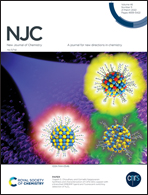A molybdenum disulfide-reduced graphene oxide nanocomposite as an electrochemical sensing platform for detecting cyproterone acetate
Abstract
A nanostructured molybdenum disulfide loaded on reduced graphene oxide (MoS2-rGO) nanocomposite is prepared using a simple and facile one-pot method. Raman spectra, XRD, TGA, SEM and electrochemical experiments are applied for the characterization of the nanocomposite. Furthermore, the MoS2-rGO nanocomposite is used as an electrochemical sensing platform for detecting cyproterone acetate (CPA). The rGO acts as an electron transfer layer that can improve the electronic transmission rate, and the introduction of MoS2 can prevent the aggregation of rGO and increase significantly the effective surface area. Owing to the synergistic effect of MoS2 and rGO, the MoS2-rGO nanocomposite film shows a wider linear range and higher sensitivity towards CPA, superior to that of the pristine MoS2 and rGO film. A linear range from 4.0 × 10−8 to 1.0 × 10−5 mol L−1 and detection limit of 1.12 × 10−8 mol L−1 for CPA are achieved. In addition, the presented method is used for detecting CPA in pharmaceutical samples with satisfactory results. This study provides a promising electrochemical sensing platform for rapid and sensitive analysis of CPA.



 Please wait while we load your content...
Please wait while we load your content...